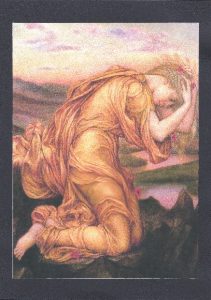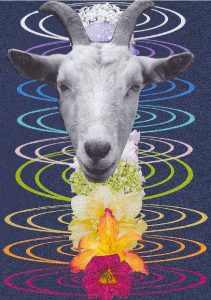April 13, 2017

I Am The One Who Shouts: Victim No More! Committee Suit. Personal Shadow Card, Permission to Post, Shaun K.
SoulCollage® and the Misunderstood Shadow
Many SoulCollage® participants fill their decks with beautiful, happy images, which are true of them, but hesitate when it comes to making a Shadow card that fosters change, transformation, and offers healing.
During a recent workshop a client, J. M. takes me aside and asks if after class we can talk about a particular card he has in his SoulCollage® deck. I say that I can recommend a therapist in Roscommon, but he insists it isn’t that kind of talk he needs. He needs a reading. Still I agree on the understanding that if it turns out to be one of those talks he’ll make an appointment with her, and he nods.
J.M. shows me the card that puzzles him: A card composed several months ago but still won’t reveal its meaning.
I ask him to place his 3 Transpersonal Cards on the table then the card in question in front of him as we proceed with the reading.
Pertaining to this card, I ask him to write three questions that he wants to know the answers to. I urge him to consider each question with care, making each one as relevant and specific as he can. He hesitates. Not knowing how to proceed, he asks if I can make some suggestions:
“If this were my card, I’d want to know the card’s name, how I should address it. Even though I might not like the fact that it has made its presence known, addressing it by name shows how much I honor and respect its appearance in my deck. Which brings me to my next question, asking why it has appeared, and what it wants me to know. As a Shadow card I would ask what it wants from me. I’d also want the help from other cards that might clarify the meaning of this one, as well as wanting to know the card that represents its Light.”
“I don’t understand. What do you mean by its light? What if I don’t want this Shadow card in my deck?”
“Wherever there is shadow there is light and visa-versa. One cannot exist without the other. This is a fact not a supposition. If I don’t have the Light card to a particular Shadow, I make it. I meditate on it and intuit its meaning as well.”
“This would make my deck twice as large,” he states, grasping his fifty some-odd-deck.
“Every card has its Shadow,” I answer.
“Even the Council Suit? I thought –?” J.M. doubts.
“The only ones that don’t have Shadows are the 3 Transpersonal Cards. They are the Source of all things material and immaterial. They take their place at the head of the table, overseeing everything.”
I give him space to digest what we shared, time to consider his questions and write them down. Before we begin the reading I tell him that I’ll be his scribe, listening and writing the responses voiced from his cards.
He turns to me and confesses that he stays away from making negative cards. “I thought we weren’t supposed to add them.”
“You mean you don’t make Shadow cards because you think they’re bad, have negative vibes, cast an evil eye or something?”
“Yeah. You know? It’s not good. I don’t want that kind of stuff in my deck.”

My Angst-Ful Girl. I Am The One Who Reminds You That To Fret Is Self-Torture. Committee Suit. Personal Shadow Card, I. Ebaen, Author
Like this client, many workshop participants confuse or misunderstand what is meant by a Shadow Card as opposed to a negative one.
Seena B. Frost wanted us to consider and represent the Shadow images in our deck. She urged us to include the cards that initially frighten, disturb, catch us unawares, and throw us off kilter. She encouraged participants to add and place these perplexing parts of our personalities on view, instead of keeping them hidden.
Yes, Seena advises not to include negative images in our decks. Yet what she refers to are the images of relatives, friends, acquaintances and co-workers, who don’t want the best for us, who wish us harm. People who, and/or places, even pets that create misery instead of joy in our lives. Their negative energy, these negative forces are not to be confused with the revelations voiced from our Shadow Cards.
If Aunt Betty mixes peanuts in your salad dressing knowing you’re allergic, you don’t want to make a card honoring the presence of this relative in your Community Suit. Understood?
What the images on our Shadow cards represent are the ways we sabotage the very things and people we love most. Actions we decide to make, to create, and then manifest that were meant, at one junction in our lives, to buffer the pain caused from the discomfort of that situation. Actions, which are truly reactions that may not be needed anymore, yet have become habitual. Ways of responding that have been learned and triggered by what the Orphan, the Destroyer, the Warrior, the Hermit, when pushed to extremes, do to survive.
If left undiscovered, unacknowledged, unrecognized, the Shadow sides that characterize our person constrict and limit our possibilities to heal.
Created to protect this body/mind, these Shadows and their traits, if they haven’t changed for the better via the lessons we’ve learned from life experience, can endanger and hamper our well-being, placing our potential for physical, emotional, and spiritual growth at risk.
By making our SoulCollage® Shadow cards, we honor ourselves by honoring and bringing to light the Shadows we hold dear, and at the same time fear. Through the use of images we reflex on and connect with what agonizes us visually, without the words, without judgment. The thoughts that we fear to feel are reflected to us in a mirror image, which is meant to relay a curative message.
We gain compassion through the use of sight. We bless what we recognize to be part of this self, this One who yearns to be understood, known and appreciated: loved whole to feel holy.
As for my client, he didn’t have to make that appointment in Roscommon. To his delight the Shadow Card caused him to smile.

I Am The One Who Tells You Not To Take Yourself Seriously. Cause After All Is Said And Done, You Die. Then Who’ll Remember That You Mattered. Committee Suit. Personal Shadow Card, Permission to Post, Jamie M.
